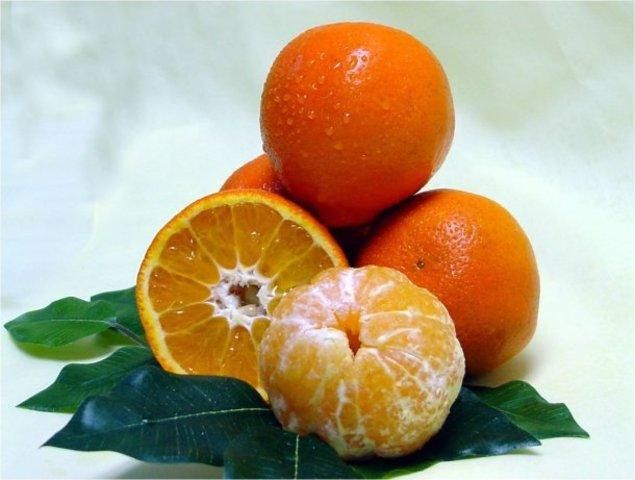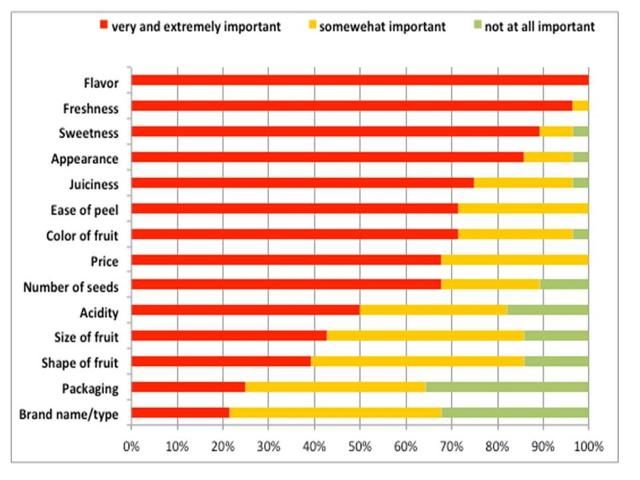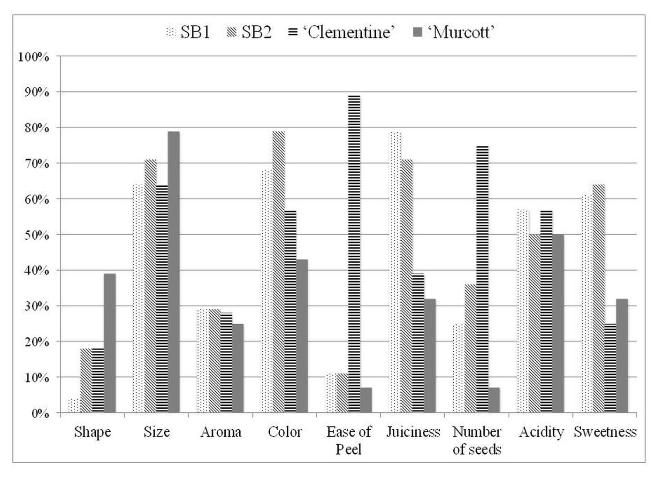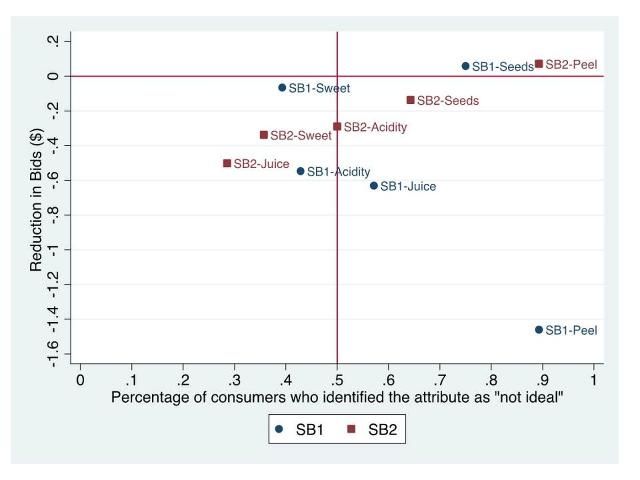Introduction
Amid the steady increase of fresh mandarin consumption (from 1.39 pounds per capita in 1991 to 4.17 pounds in 2012) (USDA/ERS 2013), Florida's share in mandarin production has decreased. California has overtaken Florida to become the major US domestic mandarin producer (USDA/NASS 2013). The major differences between mandarin production in California and Florida are the varieties grown and their fruit characteristics. 'Clementine' mandarins, which are widely grown in California, are juicy, sweet, generally seedless (the number of seed per fruit is less than six), and easy to peel (University of California–Riverside 2004). Two popular brands of California mandarins are Cuties® and Halos®, which are fruits from 'Clementine', 'W. Murcott' (also known as 'Nadorcott' or 'Afourer'), or 'Tango' mandarins. The Florida mandarin cultivar 'Murcott' (which is distinctly different from 'W. Murcott') often is referred to as Honey Tangerine. 'Murcott' fruit are juicy and flavorful but are more seedy (contain up to 24 seeds per fruit), and difficult to peel than are the 'Clementine' or 'W. Murcott' madarins (Futch and Jackson 2003). Despite a shift in consumer preferences toward the 'Clementine' mandarin, Florida growers do not produce 'Clementine' because this cultivar is not well adapted to the subtropical climate of Florida (Dou and Gmitter 2007).

Credit: UF/IFAS File Photo. 07595S
In response to the increasing market share of 'Clementine' (Norberg 2007), the Florida fresh citrus industry began researching new cultivars that are well-adapted to the Florida environment to compete against the California 'Clementine' in the consumer market. In 2009, the University of Florida introduced a new mandarin hybrid cultivar called 'Sugar Belle' (LB8-9), which is a cross between the 'Clementine' mandarin and the 'Minneola' tangelo (Gmitter et al. 2010). The 'Sugar Belle' is sweet, juicy, and fairly easy to peel. While the fruit is quite high in sugar, it has substantial acidity to balance the high sugar content (Dou and Gmitter 2007). Citrus producers have reduced the number of seeds or even eliminated seeds entirely in 'Sugar Belle' fruit by applying plant growth regulators and by growing the trees in solid blocks with minimum cross-pollination (Gmitter et al. 2010).
To determine the market potential of the new cultivar, we conducted a survey using mall intercept interviews of participants testing a variety of mandarins (House et al. 2011). The survey test results showed that the Florida 'Sugar Belle' was preferred over the California 'Clementine' mandarin and the Florida 'Murcott' mandarin (aka Honey mandarin) in terms of overall flavor, sweetness, acidity, and juiciness. However, sensory analysis alone may be insufficient to predict the market share of the new cultivar because consumers do not face tradeoffs between sensory attributes and prices in mall intercept surveys.
Aside from prices, it is important also to understand consumer preferences on internal (ease of peeling, number of seeds, and flavor) and external (appearance) sensory attributes because sensory attributes may have differential implications for designing effective marketing strategies. For example, consumers may rely on external sensory attributes (appearance) only to make an initial first-time purchase decision at the grocery store (Poole and Martinez-Carrosco 2007) since they usually do not have experience with the internal sensory attributes (ease of peeling, number of seeds, and flavor) before a first-time purchase. In contrast, repeated purchase decisions can be highly influenced by internal sensory attributes. It was shown that consumers ranked number of seeds as the most important attribute for fresh mandarin, followed by price, blemish, color, size, cultivar, and production region (Campbell et al. 2004). To market 'Sugar Belle' mandarins effectively against the main competitors, the effect of external and internal sensory attributes on consumer choice must be understood.
It should be noted that 'Sugar Belle' is currently grown in the east-coast and north-central regions in Florida. The two regions produce fruit with significantly different characteristics that result from differences in climate and growing practices. The north-central region of Florida has a cooler climate, so mature 'Sugar Belle' fruit from this region is larger than fruit from the east coast region. We refer to the fruit grown in north-central region as SB1 and fruit grown in east coast region as SB2 hereafter. The east-coast region of Florida has a warmer climate, so SB2 fruit are relatively small, usually the size of small to medium mandarins, although cross pollination can sometimes produces some larger fruit. The smaller SB2 fruit are a result of growth regulator applications that increase the set of fruit from flowers that may not have been adequately cross-pollinated; these fruit have few seeds or are seedless. Any effective marketing plan for Florida mandarins must address the need to identify the advantages and disadvantages of each type of 'Sugar Belle' (SB1 and SB2) mandarins compared to the competitor mandarins.
We used a survey to determine consumer willingness to pay (WTP) for specific attributes (appearance, ease of peeling, number of seeds, and flavor) to determine the most desirable characteristics by comparing two different types of 'Sugar Belle' (SB1 and SB2) with the main competing product to identify the most desirable characteristics and to determine the best marketing and pricing strategy.
Survey Method
Previous studies often used sensory evaluation and experimental auctions to valuate consumer willingness to pay (WTP) for sensory attributes of fresh fruits (Roosen et al. 1999; Jaeger and Harker 2005; Lund et al. 2006; McCluskey et al. 2007; Zhang et al. 2010; Gallardo et al. 2011). For our survey, we combined sensory evaluation and experimental auctions in a unique way. Specifically, sensory evaluations and auctions were conducted in three stages: viewing, peeling, and tasting of mandarins. The viewing stage represented the first-time purchase transaction, while peeling and tasting provided additional information for repeat purchase transactions. Thus, the results from the experimental auctions were able to better approximate the process of repeated market transactions. Additionally, the winning bids (marketing clearing price) of the last round of bidding were posted, which allowed participants to consider market feedback that yielded a valuation more consistent with neoclassical economic theory (Lusk and Shogren 2007). The auction was conducted for nine rounds. To keep all participants engaged throughout nine rounds, winner of the auction was not immediately determined after each round. Instead, a random number from one to nine was drawn to determine which round was chosen as the binding round, in which the winners of that round would win the products and exchange money with the moderator.
The auction and sensory analysis took place in Atlanta, Georgia. Twenty-eight participants were randomly selected through a marketing research firm. Two sessions of auctions were conducted based on regular and non-regular consumption of citrus fruits. The first session/auction was for participants who regularly consumed citrus fruits, and the second session/auction was for participants who did not regularly consume citrus fruits. There were 15 participants in the first auction and 13 in the second auction. Each auction lasted 90 minutes. When participants arrived at the auction, they were asked to complete an initial questionnaire containing questions about their socio-demographics, their citrus consumption and purchase habits, the amount of citrus they currently had at home, and their hunger level.
After completing the initial questionnaire, participants were give $10 cash and were told that this was a portion of their compensation payment for their time and was to be used for bidding in the auction. Participants were then led through a training session of a fifth-price auction in which bidders simultaneously submit their sealed bids for a good, and the four highest bidders win the auction and pay the fifth highest price.
For the auction, each participant was given a five-pound bag of Florida 'Murcott'. At the front of the room, there was a display of three five-pound bags each containing one of the following: California 'Clementine' (Cuties), 'Sugar Belle' SB1, or 'Sugar Belle' SB2. The Florida 'Murcott' and the California 'Clementine' samples were purchased from the local supermarket on the day of the auction. The two 'Sugar Belle' samples (SB1 and SB2), which were purchased from two growers (one north-central grower and one east-coast grower), were harvested one week before the auction and were kept in temperature-controlled cold storage until the day of the auction. For the sensory analysis, each participant was given four small plates, each containing one type of mandarin labeled with a random three-digit number (consumers were unaware of which were which of the mandarin varieties). Participants were instructed not to peel the mandarin sample, but to simply look at it, and pick it up if they liked, as if they were choosing mandarins at a grocery store. Before beginning the auction, participants were asked to identify their ratings for external appearance characteristics of the mandarins, such as overall appearance, color, aroma, size, and shape using a five-point Just-About-Right (JAR) scale (e.g., for size, 1= much too big, 2=a little too big, 3=just about right, 4=a little too small, 5= too small). Participants then bid in three rounds to exchange their five-pound bag of Florida 'Murcott' for one of the other three mandarin types. Next, participants were asked to peel the four mandarin samples and to evaluate the ease of peeling and color of the fruit flesh. This process was repeated in three additional rounds of bidding. At the end of the sixth round, participants were asked to taste the four samples and to evaluate the overall flavor, sweetness, acidity, juiciness, and number of seeds of the samples. The auction continued for three final rounds. At the end of the ninth round, the binding round was chosen, winners were identified, and money was exchanged for the mandarins.
Survey Results
Before the sensory evaluation and auctions, participants were surveyed on the importance of attributes when purchasing mandarins (Figure 1). In this experiment, most participants gave the highest importance to flavor, followed by freshness, sweetness, juiciness, ease of peeling, price, and number of seeds, respectively. Participants were least concerned about packaging and brand names.

After the experiment, the ideal characteristics of each mandarin were analyzed (Figure 2). A greater percentage of participants rated the 'Murcott' as having the ideal shape and size compared to the 'Clementine' and 'Sugar Belle' SB1 and SB2. More participants considered both the 'Sugar Belle' SB1 and SB2 to have ideal aroma and color compared to the 'Murcott' and 'Clementine'. After the participants peeled each fruit, approximately 89 percent rated the 'Clementine' as very easy to peel compared to an easy-to-peel rating of 11 percent for both 'Sugar Belle' SB1 and SB2, and 7 percent for 'Murcott'. More than 70 percent of the participants rated both 'Sugar Belle' SB1 and SB2 as having the ideal amount of juiciness, while around 33 percent considered the 'Clementine' and the 'Murcott' to be ideal in this attribute. As expected, the majority of the participants (75%) rated 'Clementine' as having the ideal number of seeds compared to 25 percent for 'Sugar Belle' SB1, 36 percent for 'Sugar Belle' SB2, and only 7 percent for 'Murcott'. Slightly more than 60 percent rated both 'Sugar Belle' SB1 and SB2 as having the ideal amount of sweetness compared to only 25 percent for 'Clementine' and 32 percent for 'Murcott'.

The focus of the survey was placed on the sensory attributes of 'Sugar Belle' SB1 and SB2 (ease of peeling, acidity, juiciness, sweetness, and number of seeds). Differences in the bids between participants who rated these sensory attributes as either ideal or non-ideal were calculated. The differences in bids were then plotted against the percentage of participants who thought the sensory attributes were non-ideal (Figure 3). A penalty analysis (although univariate) was used to identify the attributes that needed the most improvement. Specifically, this was the point in the plot that showed a large drop in bids and a large percentage of consumers indicating that the corresponding attribute needed to be modified (Schraidt 2009).

Starting from the lower right corner of Figure 3, we found that around 90 percent of the participants rated the ease of peeling for 'Sugar Belle' SB1 to be non-ideal, with the drop in bids as large as $1.40 for a five-pound bag of the fruit. Although over 70 percent of the participants considered 'Sugar Belle' SB1 to not have the ideal number of seeds, the bids did not decrease due to this attribute. This observation, combined with our observation on ease of peeling, suggested that ease of peeling 'Sugar Belle' SB1 should be prioritized to improve, followed by number of seeds, juiciness, and acidity.
In addition, bids for 'Sugar Belle' SB2 did not drop as much as for 'Sugar Belle' SB1 even though around 90 percent of the participants rated the ease of peeling 'Sugar Belle' SB2 to be non-ideal. Similarly, although over 60 percent considered 'Sugar Belle' SB2 to not have the ideal number of seeds, the bids for 'Sugar Belle' SB2 did not decrease. This indicated that other sensory attributes of 'Sugar Belle' SB2 offset the failure to achieve ideals for ease of peeling and number of seeds.
To estimate the WTP or the dollar values for each sensory attribute, three multivariate regression models were estimated, with the bids submitted as the dependent variable for each stage of the experiment: observation/viewing, peeling, and tasting. Other variables were included in the model based on previous research: in-home inventory of mandarins (Colson et al. 2009) and hunger level (Briz et al. 2010) because these factors have been shown to influence consumer WTP. Demographic characteristics, such as household size, employment status, and children in the household, also were included.
After the initial viewing stage, the overall appearance of the fruit was found to be positive and significant in determining the bids. However, after the peeling stage, the ease of peeling became more important than appearance to consumers. Holding other variables at their means, improving the ease of peeling by one standard deviation resulted in an increase of $0.05/lb. After the tasting stage, where participants experienced both the internal and external sensory attributes of the mandarins, consumers were willing to pay higher prices for the ideal amount of acidity and number of seeds than they were for ease of peeling or appearance, while ease of peeling became insignificant. Holding other variables at their means, reducing the number of seeds resulted in a WPT increase WTP by $0.03/lb, while improving the amount of acidity resulted in a WTP increase of $0.06/lb.
Discussion
This survey demonstrated how experimental auctions can be combined with sensory analysis to determine a better understanding of consumer preferences for food attributes. Conceivably, such analyses might be a valuable tool for fruit breeders to use when contemplating the release of new cultivars.
Results from the auction and sensory analysis confirmed expectations that unobservable internal sensory attributes at the time of purchase may have a greater influence on WTP than do observable external sensory attributes. During the first stage of the auction, external appearance was positively and statistically significantly related to the bid, but this changed during the second and third stages of the auction based on ease of peeling and internal attributes (e.g., taste) of the mandarins. Hence, in-store samples might be a good strategy for introducing new products that perform better on internal sensory criteria than on external sensory criteria. Based on our survey results, this information would alter consumer WTP for the product.
Our survey also indicated that consumer WTP could be higher for 'Sugar Belle' SB1 and SB2 if the number of seeds and ease of peeling are improved, especially for 'Sugar Belle' SB1. Given the existing sensory attributes, both 'Sugar Belle' SB1 and SB2 should be priced lower than the 'Clementine' but higher than the 'Murcott' in order to compete against the 'Clementine'. However, to avoid cannibalization on the market share of the 'Murcott', the price of 'Sugar Belle' SB1 and SB2 should be closer to the 'Clementine' than to the 'Murcott'.
Another interesting feature of this survey was consumer perception of 'Sugar Belle' SB1 and SB2. These two types of mandarins are produced in different Florida regions and have different production characteristics, which resulted in different perceptions of 'Sugar Belle' SB1 and SB2. The survey participants preferred 'Sugar Belle' SB2 over 'Sugar Belle' SB1. Specifically, 'Sugar Belle' SB2 received higher ratings in shape, size, ease of peeling, sweetness, and number of seeds, whereas 'Sugar Belle' SB1 received higher ratings in acidity and juiciness. To build a consistent brand image, it will be important to provide consistent experiential experiences for consumption. Because it may be infeasible to produce fruits with consistent characteristics across different regions, two different marketing strategies will be needed for 'Sugar Belle' SB1 and 'Sugar Belle' SB2. A comparison of 'Sugar Belle' SB1 and SB2 shows that 'Sugar Belle' SB1 is larger and is similar in size and shape to the bell-shaped 'Minneola' tangelo, while 'Sugar Belle' SB2 is smaller and is similar in size and shape to the round 'Clementine' (Cutie) mandarin. 'Sugar Belle' SB1 could be marketed to complement 'Minneola' tangelos in the gift fruit market, while 'Sugar Belle' SB2 could be marketed in grocery stores to compete with the 'Clementine' mandarin.
References
Bi, X., L. House, Z. Gao, and F. Gmitter. 2012. Sensory evaluation and experimental auctions: Measuring willingness to pay for specific sensory attributes. American Journal of Agricultural Economics 94(2):562–568.
Briz, T., A.C. Drichoutis, R.M. Nayga Jr., and L. House. 2011. Examining projection bias in homegrown value auctions. Working paper, Departamento de Economia y Ciencias Sociales Agrarias, Universidad Politécnica, Madrid, Spain.
Campbell, B.L., R.G. Nelson, R.C. Ebel, W.A. Dozier, J.L. Adrian, and B.R. Hockema. 2004. Fruit quality characteristics that affect consumer preferences for Satsuma mandarins. HortScience 39(7):1664–1669.
Colson, G., W.E. Huffman, and M.C. Rousu. 2009. Demand curve effects in experimental auctions: The effect of quantity already owned. AAEA Conference, Milwaukee, WI (July). https://ageconsearch.umn.edu/record/49551. Accessed August 12, 2022.
Dou, H. and F. G. Gmitter. 2007. Postharvest quality and acceptance of LB8-9 mandarin as a new fresh fruit cultivar. HortTechnology 17(1):72–77.
Futch, S. and L.K. Jackson. 2003. Murcott (Honey Tangerine). EDIS #CH078. UF/IFAS Extension, Gainesville, FL. https://edis.ifas.ufl.edu/publication/ch078.
Gallardo, R.K., Kupferman E., and A. Colonna. 2011. Willingness to pay for optimal Anjou pear quality. Hortscience 46(3):452–456.
Gmitter, F. Jr., W. S. Castle, and J. W. Grosser. 2010. United States patent application: Mandarin tree named 'LB8-9' (May 20, 2010). United States Patent and Trademark Office, Washington, D.C.
House, L.O., Z. Gao, T.H. Spreen, F.G. Gmitter Jr., M.F. Valim, A. Plotto, and E.A. Baldwin. 2011. Consumer Preference for Mandarins: Implications of a Sensory Analysis. Agribusiness: An International Journal 27:450–464.
Jaeger, S.R. and F.R. Harker. 2005. Consumer evaluation of novel kiwifruit: Willingness to pay. Journal of the Science of Food and Agriculture 85:2519–2526.
Lund, C.M., S.R. Jaeger, R.L. Amos, P. Brookfield, and F.R. Harker. 2006. Tradeoffs between emotional and sensory perceptions of freshness influence the price consumers will pay for apples: Results from an experimental market. Postharvest Biology and Technology 41:172–180.
Lusk, J.L. and J. Shogren. 2007. Experimental Auctions: Methods and Applications in Economic and Marketing Research. Cambridge, UK: Cambridge University Press.
McCluskey, J.J., R.C. Mittelhammer, A.B. Martin, and K.S. Wright. 2007. Effect of quality characteristics on consumers' willingness to pay for Gala apples. Canadian Journal of Agricultural Economics 55:217–231.
Norberg, R. 2007. Fresh citrus viability: Market trends and competition. Post-Harvest Pest Control Conference, Santa Barbara, CA (April).
Poole, N. and L. Martinez-Carrasco. 2007. Information and WTP: Fruit quality perceptions and consumer satisfaction. Mediterranean Conference on Agro-Food Social Scientists. Barcelona, Spain (April).
Roosen, J., J.A. Fox, D.A. Hennessy, and A. Schreiber. 1998. Consumers' valuation of insecticide use restrictions: An application to apples. Journal of Agricultural and Resource Economics 23(2):367–84.
Schraidt, M. 2009. Appendix L: Penalty analysis or mean drop analysis. In: Just-About-Right (JAR) Scales: Design, Usage, Benefits, and Risks [ASTM Manual MNL63], Conshohocken, PA: ASTM International.
University of California–Riverside. 2004. Citrus Variety Collection. University of California–Riverside Citrus Variety Collection website. https://citrusvariety.ucr.edu. Accessed August 12, 2022.
USDA/ERS. 2013. Fresh fruit: Per capita consumption, 80-to date. The Fruit and Tree Nuts Yearbook Spreadsheet Files (89022), United States Department of Agriculture (USDA), Economic Research Service (ERS), Washington, D.C.
USDA/NASS. 2013. Citrus Fruits Summary. Agricultural Statistics Board, United States Department of Agriculture (USDA), National Agricultural Statistics Service (NASS), Washington, D.C.
Yue, C. and C. Tong. 2009. Organic or local? Investigating consumer preference for fresh produce using a choice experiment with real economic incentives. HortScience 44(2):366–371.
Zhang, H., R.K. Gallardo, J.J. McCluskey, and E.M. Kupferman. 2010. Consumers' willingness to pay for treatment-induced quality attributes in Anjou pears. Journal of Agricultural and Resource Economics 35(1):105–117.